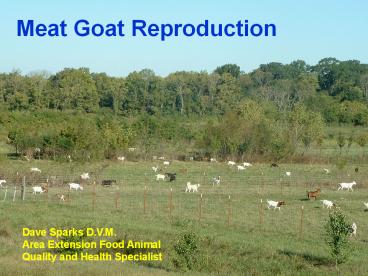Meat Goat Reproduction - PowerPoint PPT Presentation
1 / 18
Title:
Meat Goat Reproduction
Description:
The female is born with a predetermined number of haploid cells, the ova or egg ... Libido determination must be made from observations over time. ... – PowerPoint PPT presentation
Number of Views:694
Avg rating:3.0/5.0
Title: Meat Goat Reproduction
1
Credits and Thanks toDr. Richard
BrowningTennessee State University
Meat Goat Reproduction
Dave Sparks D.V.M. Area Extension Food Animal
Quality and Health Specialist
2
Weaning Traits of Boer Does (3 Matings)
3
Estimated Gross Revenue (120/cwt for kids,
36-50 lbs., Sel. 2, 9/8/06)
4
Male Reproductive System
The male continues to manufacture haploid cells,
the sperm, throughout his life.
5
Female Reproductive Tract
The female is born with a predetermined number of
haploid cells, the ova or egg cells, in her ovary
and will never make any more.
6
Goat Estrous Cycle
- Anestrous
- The time between breeding seasons when the doe is
not coming into heat - Estrus
- The time the doe is in heat
- Metestrus
- The time between heat periods when the doe is
trying to become pregnant
7
Anestrus
- Goats are seasonal breeders. Anestrous is the
part of the year when does are not cycling. - All reproductive hormone levels are low.
- The onset and decline of the breeding season are
controlled by day length and buck activities. - Poorly influenced by drugs, but can be influenced
by artificial lights and teaser bucks.
8
Estrus
- This is the period just before, during and just
after the egg is released in the ovary. - The dominant structure on the ovary is the
follicle which releases estrogen as the dominant
hormone in the system. - The estrogen causes the doe to be receptive to
the male.
9
Metestrus
- The part of the cycle between heat periods.
- The dominant structure on the ovary is the Corpus
Luteum and the dominant hormone is progesterone. - Under the influence of progesterone the doe
rejects the buck and the reproductive tract
undergoes changes to allow for attachment of the
embryo and support of the pregnancy.
10
(No Transcript)
11
(No Transcript)
12
(No Transcript)
13
(No Transcript)
14
(No Transcript)
15
(No Transcript)
16
(No Transcript)
17
(No Transcript)
18
How Big is Big Enough?
19
(No Transcript)
20
Nutrition and Reproduction
- Flushing Increasing nutritional plane by adding
.5 lbs of corn or protein supplement for 2 weeks
before and 2 weeks after breeding increases
pregnancy rate and litter size at birth. - Does in good body condition at breeding deliver
more kids and have better kid survival rates. - Pregnancy toxemia
21
Pregnancy Toxemia
- Inadequate carbohydrates in diet in last
trimester causes mother to metabolize her body
fat. - By product is ketones which build up to toxic
levels. - Doe carrying twins, carbo requirement increases
to 180, with triplets 240. - Doe should gain ½ lb. day last trimester.
22
Pregnancy Diagnosis
- Can reduce costs, increase income, and maximize
returns on available inputs. - Several possibilities, each with advantages and
disadvantages. - Doppler Ultrasound
- A Mode Ultrasound
- Blood Hormone Assay
23
Doppler Ultrasound
- Expensive to purchase.
- Delicate and only somewhat portable.
- Requires extensive training and practice to use
accurately.
- Accurate and early results.
- Use with multiple species and multiple
functions. - May show number of fetuses.
- Slower to operate accurately.
24
Ultrasound of 55 day Pregnancy
25
A Mode Ultrasound
- Inexpensive to purchase and operate
- Purchase preset for one type of animal.
- Quickly operate successfully.
- Accurate at 30 to 40 days.
- Audio tones. Can not tell how many kids are
present. - Tough and easily portable.
26
Blood Chemical Assay
- BioPRYN Measures the amount of a very specific
protein, released from the plancenta, present in
the maternal blood.
- Accurate at 26 days
- 95 accurate
- Samples received in lab by Wednesday are reported
Friday - Cost is 7.50/test supplies and shipping
- www.biotracking.com
- 208-882-9736
27
Assisted Reproduction
- Artificial Insemination
- Embryo Transfer
Valuable tool for increasing the impact of
outstanding genetics, but also require increased
management, cost, and risk.
28
Artificial Insemination
- Bucks are collected via
- Artificial Vagina and estrus doe
- Electro-ejaculator
- Semen is examined, extended, and frozen.
- Semen is placed above or just inside the cervix
by means of a glass speculum and pipette. - Typical conception rates are 30-50 for one
insemination or 60-80 with 2 or three
inseminations. - May get 2 or 3 straws with one certificate.
- Laparoscopic AI increases the success rate but
also the danger to doe and the cost.
29
Embryo Transfer
High value doe is synchronized with lower value
does, super-ovulated, and bred to high value
buck. At about 1 week of pregnancy the fertile
embryos are flushed from the donor doe and
introduced surgically into heat synchronized
recipient does.
- Typically harvest from 0 to 20 fertile embryos
from donor. - Very expensive and management intensive, must
have strong market for high value kids. - Difficult to do legally in goats due to
restrictions on drugs used in the procedure.
30
Buck Breeding Soundness Examination
- Not so much to identify sterile males as to
identify marginally fertile males. - Late kidding, low conception rates and small
litter sizes cost big dollars. (Especially since
goats are seasonal breeders and goat markets are
seasonal)
31
Breeding Soundness Exam
- Evaluation of semen sample
- Semen volume and concentration
- Correct morphology
- Motility
- Physical examination for ability to breed
- Reproductive system
- Musculoskeletal system
- Libido determination must be made from
observations over time.
32
Your local veterinarian can help you identify
problems before they are problems.
- Oklahoma Veterinary Medical Association
- www.okvma.org
- American Association of Small Ruminant
Practitioners - www.aasrp.org
33
Questions?































